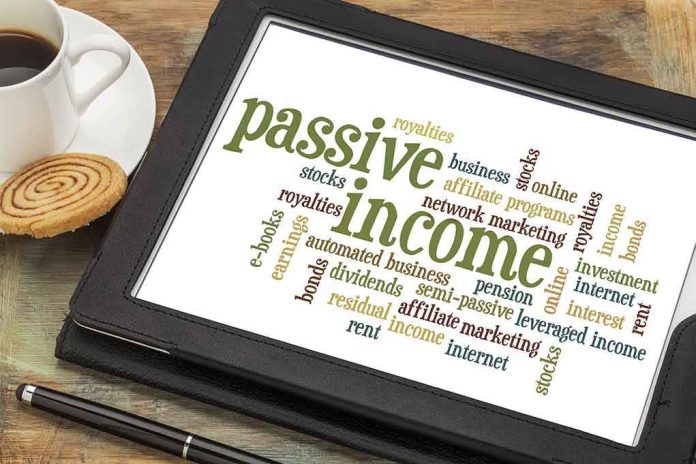
AI is rewriting the rules of passive income, turning what was once a pipe dream into an accessible, tech-driven reality for millions in 2025.
Story Snapshot
- ChatGPT’s recommendations are fueling a new wave of low-barrier, automated passive income strategies that anyone with internet access can pursue.
- Real estate crowdfunding, print-on-demand, digital products, and YouTube automation dominate the landscape, each offering unique risks and rewards.
- AI tools are not only generating business ideas but also running much of the daily grind, lowering the expertise and effort needed to start earning.
- Market saturation and regulatory scrutiny are rising, making due diligence and adaptability more crucial than ever.
AI Unlocks the Passive Income Floodgates in 2025
Every economic cycle creates its own breed of side hustle, but in 2025, the hunger for passive income is at a fever pitch. Blame it on inflation, job insecurity, or the relentless march of technology—everyone wants a piece of the “earn while you sleep” pie. ChatGPT, the generative AI at the center of this movement, is now being used not just for quirky conversations but for mapping out entire financial strategies. Its recommendations have hit the mainstream, appearing in publications and social feeds, promising that with the right platform and approach, even the uninitiated can build meaningful streams of income without quitting their day jobs.
AI is the new gatekeeper, and it’s democratizing access to money-making opportunities that once required insider knowledge or substantial capital. Real estate crowdfunding, for example, now allows regular investors to buy into fractional property deals with as little as $10. This is a seismic shift from the days when real estate was reserved for the well-heeled or the reckless. According to financial experts, the key appeal is hands-off investing—no tenants, no toilets, just a monthly payout, though illiquidity and platform risk remain ever-present shadows.
Print-on-Demand, Digital Products, and the Automation Boom
Print-on-demand stores and digital product marketplaces have exploded in popularity, driven by their promise of scalability and minimal startup costs. ChatGPT’s scripts can generate book drafts, course outlines, or even product descriptions in minutes. Entrepreneurs now launch Shopify or Etsy stores with AI-generated designs, letting fulfillment partners handle inventory and shipping. The catch? Success requires marketing savvy and persistence—platforms are crowded, and only those who carve out a niche stand out. Digital products, especially online courses and templates, have proven to be goldmines for those who master content creation and promotion. Upfront effort is necessary, but the potential for $5,000 or more in monthly sales keeps this strategy atop ChatGPT’s list.
YouTube automation is the latest darling of the passive income world. Channels built on faceless videos—scripts, voices, and editing all handled by AI—can rack up thousands in ad revenue with little human intervention. But this arms race comes with its own risks: demonetization, copyright claims, and ever-tightening platform rules can wipe out income streams overnight. The winners are those who blend automation with authenticity, adapting quickly to platform changes and audience preferences.
The Risk-Reward Equation: What AI Won’t Tell You
Every passive income method comes with trade-offs. Real estate crowdfunding offers attractive yields but can lock up your money for years. Print-on-demand is easy to start but fiercely competitive. Digital products and courses scale beautifully, yet require ongoing marketing and regular updates to stay relevant. Dividend stocks and REITs remain solid picks for the risk-averse, but their returns are tethered to broader market swings and can be cut unexpectedly. High-yield savings accounts offer safety, but inflation can quietly erode purchasing power. Peer-to-peer lending tempts with high returns, though platform failures and borrower defaults are not uncommon. ChatGPT’s advice consistently echoes a classic principle: diversify, research, and don’t bet the farm on any one strategy.
Regulation is the wild card in 2025’s passive income game. As AI-generated content floods platforms, scrutiny grows. Financial authorities are eyeing both the advice given and the platforms themselves, aiming to protect consumers from scams and ensure fair play. Those who succeed will be the ones who stay nimble—adapting to new policies, leveraging the latest tools, and continuously learning to stay ahead of the pack.
Expert Analysis: Is the Dream Built to Last?
Industry analysts agree: the democratization of passive income is real, but so are the pitfalls. Diversification is not just smart; it’s essential. The best strategies combine multiple streams—real estate, digital products, and dividend investments—tailored to individual risk tolerance and skill sets. Digital literacy is now a prerequisite, not a bonus. Those who invest time in learning new platforms, marketing, and automation tools consistently outperform the rest. AI is a powerful ally, but overreliance is dangerous; platform algorithms and policies can change overnight, turning yesterday’s goldmine into today’s ghost town.
For the 40+ crowd, the allure of passive income is not just about wealth—it’s about control. AI-fueled strategies offer a way to hedge against economic uncertainty and reclaim some financial autonomy. Yet, the landscape is increasingly competitive and complex. The most successful passive income earners approach these opportunities with skepticism, adaptability, and a willingness to learn. They treat ChatGPT as a springboard, not a crystal ball, and always keep an eye on the fine print.





